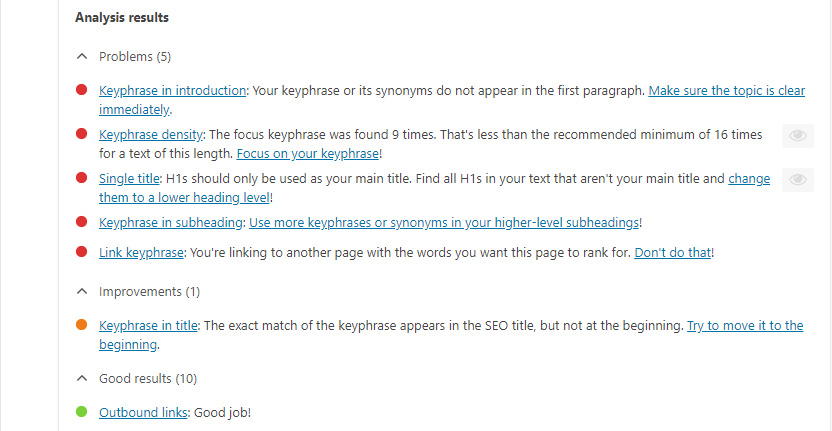News Courtesy of Yoast.com:
In next couple of months, Yoast SEO 10.0 will see the light of day. In it, you’ll find a brand new SEO analysis. One that’s based on thorough SEO research. Last year, we evaluated all existing assessments and added new ones to make the analysis reflect the search engines of today. You can now try out this brand new analysis! In Yoast SEO 9.4 you can easily switch from the current to the new analysis (and back). So, go ahead and see if your content meets the SEO standards of today! We’d love to hear your feedback.
Why a new analysis?
Search engines evolve. What used to be important a decade ago might not be relevant today. As search engines become smarter, our SEO analysis should too! That’s why we decided to test if all our checks are still relevant.
A multidisciplinary team, consisting of SEO experts, linguists and developers, scrutinized the SEO analysis: Are some SEO assessment redundant nowadays? Should we add new ones? Or change the weight of certain factors? We checked all of them, removed some, added a new assessment and adapted the calculations. For details on the changes in the new analysis, please check the release post of Yoast SEO 9.4.
I’m a big fan of the Yoast team. Sure, there have been some mistakes along the way, but their transparency and honesty speak volumes to the integrity of their products. While I’ve only used the free version of Yoast SEO it has more than enough features to make you a better blogger.
Aside from the SEO analysis, the readability score is something that should be followed too. I always strive to have both features get a green score. The biggest problems that readability helps me tackle are the use of subheadings (to break up long sections of text) and also minimizing the use of passive voice. Combine this feature with Grammarly and it’ll help make your articles more concise and professional-looking.
The new SEO analysis feature can be turned on with the latest version of Yoast SEO. It’s available via a toggle button in the plugin’s general settings. I actually just enabled it for this website. This prompted me to go back to one of my longer posts to see if the color indicator changed. While this post still reports as green, a few new problems were displayed. One of them I disagree with.
Multiple Use of H1 Tags
A new problem I’ve noticed is reported as Single Title. This refers to having more than one H1 tag in a post. Generally, this is sound advice as I agree that H1 should be reserved for the focal point or topic of the article. However, I think some exceptions should be allowed and that this red problem should be moved to a yellow warning indicator.
For instance, what if you have a really long post where multiple main topics are discussed? There are only 6 header tags available and with a 4000-word post you might go through them rather quickly. Such is the case with the post I’m testing with the new SEO analysis tool.
This post was a merge of two related posts which I wanted to combine as one mega post. I employ two strategies for structuring header tags in my articles:
- Descending Order: Sections are separated in order from H1,H2,H3,H4,H5 and H6. Generally used for shorter more focused posts.
- Nesting Tags: Sections with multiple sub-sections use the next header tag in order. This order is reset when a new main section is discussed. Check out my example below.
You can see the methodology behind this structure by giving Google a layout that distinguishes these topics by the level of importance and relatability. 6 Heading tags should be enough to cover multiple sections, sub-sections, etc. But what if it isn’t? What if you want to enhance your post by introducing a new topic? Sure, you could create a separate post but it might be better to combine them into one for SEO purposes.
Given the example above, one might think it’s easy enough to add other H2 headers such as Cat Products, Ferret Products, etc. However, if you want to go broader, these tags may need some major adjustments. If the main H1 title is Animal Products and you want to expand further, It’s my belief that multiple H1’s are okay in this instance.
What I would do is keep that h1 title (probably the post title) the same and add additional h1 tags. These h1’s would include mammals, reptiles, birds, fish, and amphibians. Can you imagine how much of a pain it would be to restructure all of those heading tags? Not to mention if you already use h6 tags, you’ll have problems with restructuring.
Why I Believe Multiple H1’s Are Okay
It’s simple. This post from 2017 contains a direct response on this issue from Google’s John Mueller. What’s the answer? “Use as many as you want”.
It’s certainly not what I expected. Although, apparently Google is smart enough to rank a page based on content regardless of header tag structure. I would still suggest you follow some type of scheme. Don’t go adding an h1 tag followed by an h6 tag.
So there you have it. I’m definitely not implying that I’m more knowledgeable than the Yoast team when it comes to SEO. All I’m saying is that I don’t always agree with their assessment 100% of the time. Still, in my opinion, there is no better alternative plugin for SEO analysis in WordPress!



